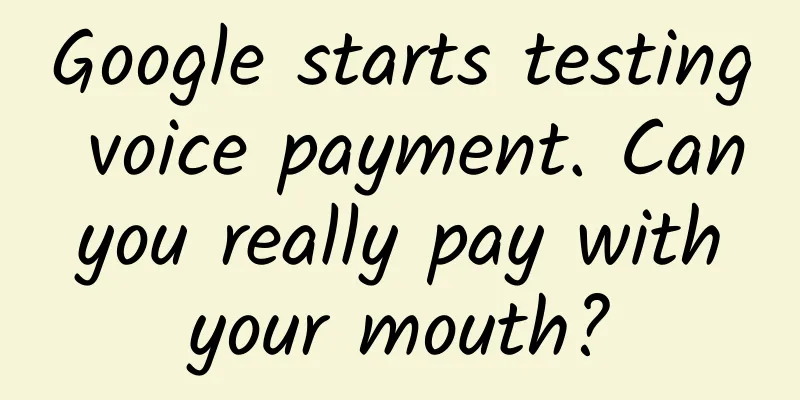Google starts testing voice payment. Can you really pay with your mouth?

|
With the advancement of technology, the means of mobile payment have been changing with each passing day. From the cumbersome password input in the early days, there are now more convenient and secure fingerprint and face recognition. However, voiceprint recognition, which is now very common on smartphones, is rarely used in the payment field. Recently, there is news that Google has begun to implement this voice payment function in its products, which allows users to pay with their mouths. According to relevant media reports, Google is currently testing a new feature that will allow consumers to use Voice Match to authorize and confirm payment. Google also confirmed that not all purchases will provide voice recognition, and at this stage this feature is only applicable to in-app purchases and restaurant orders, not Google Shopping.
According to the report, this voice payment function was originally planned to be released at this year's I/O developer conference, but due to the epidemic, it had to skip the release and start testing directly. Currently, in the payment interface of Google Assistant, you can see the option of "Confirm with Voice Match". In fact, voice payment technology is not new, and is even older than natural language processing (NLP) that voice assistants rely on. Yes, although both voice payment and natural language processing are related to voice, there is a world of difference between the two. The essence of voice payment is voiceprint recognition, but voiceprint recognition is obviously not equal to voice recognition. Sound wave transmission is a data communication mode that uses sound as a transmission method. For example, the process of speaking can be understood as the process of encoding signals into sound. The process of listening is the process of decoding audio signals into language and text. The correspondence between the Chinese characters and pinyin used is actually equivalent to the audio protocol. However, voiceprint recognition is a personal recognition, which requires extracting the voiceprint characteristics in the voice to determine who is speaking, that is, to solve the problem of "who is speaking". Speech recognition is a common recognition, which determines the content of the speech and solves the problem of "what was said". Obviously, the most important thing in voice payment is to determine who is the person who issued the payment command. Since the size and shape of each person's vocal organs are unlikely to be exactly the same, these differences also lead to changes in the vocal airflow, which in turn produce differences in voiceprints. That's why we can "hear the voice before seeing the person" and judge the identity of the voice owner through timbre, pitch and speaking habits. Similarly, we can use algorithms to extract obvious, abstract and high-dimensional voiceprint features from voice information, and use deep learning to train the model, and then use unique biological features to prove the proposition of "I am myself". In fact, the process of using voiceprint recognition to complete voice payment is very simple. The user sends a sound wave with a certain command, and the terminal device obtains this sound wave and converts it into a session, and sends the specific product information and transaction number to the Google backend. After matching the voiceprint information on the server side, the transaction operation can be started, and finally the information of the completed transaction is pushed to the Google voice assistant. Before Google confirmed that it was testing voice payment, Amazon had already begun allowing users to pay bills on its Alexa last fall using voice commands. Once the user approves the transaction using something like "Alexa, pay my mobile bill," Alexa will use Amazon Pay to pay the bill amount and send a confirmation via the user's registered mobile phone number. In addition, Tmall Genie in the domestic market has also long been able to use voice payment. According to data released by Alibaba, during the Double 11 period last year alone, a total of 1.05 million orders on Tmall Genie were successfully paid by speaking. However, what Google wants to achieve is obviously not just using voice payment on its own Google Home smart speaker, but is aiming at smart voice assistants that are more applicable to a wider range of scenarios. But what Google can think of, can't Amazon and Alibaba think of it? Fully integrating voice payment on smart voice assistants will undoubtedly greatly improve the user experience. After all, compared with face and fingerprint recognition, voiceprint recognition is much more convenient. However, Amazon and Alibaba chose to limit this function to smart speakers, which are usually placed at home. There is a reason for this. Compared with fingerprint or facial information, voice is less controllable. After all, users can decide whether to put their fingers on the fingerprint recognition module or put their faces in front of the camera, but they cannot control the transmission of sound in this way. More importantly, fingerprint information is difficult to collect, and facial recognition usually requires liveness detection, but voiceprint recognition is not only easy to collect, but also difficult to determine the user's state when speaking the payment command. In addition, AI technology has been fully spread today. Through deep learning models and waveform editing tools, the voice data of specified content can be spliced, and the user's voiceprint spectrum can be almost completely reproduced. The security issues of voice payment do not only occur on the client side, the server side also faces certain risks. Voice payment can be regarded as a data interaction. For example, the cookie mechanism adopts a solution to keep the state on the client side, while the Session mechanism adopts a solution to keep the state on the server side. When the user visits the server for the first time, a Session will be created for the client, and a Session ID will be calculated through a special algorithm to identify the object. However, since voice payment is not a one-time behavior, the next time the user interacts with the server, the data must be completed through SessionID. However, the implementation mechanism of SessionID makes it possible to be hijacked, such as classic XSS cross-site scripting attacks, network sniffing, proxy hijacking and other different attack modes. If SessionID is hijacked, the hacker can obtain the legitimate session of the target user, and then empty the victim's wallet like credit card fraud. Therefore, this may be one of the important reasons why Google itself admitted that if the feedback and performance are too negative, the feature may not even be launched to the public. Therefore, before Google solves the critical security issues, if you want to complete the shopping experience by opening your mouth, it may only be possible on smart speakers for the time being. |
<<: Will QR codes be scanned by humans? Yes! But we can’t wait for that day
>>: Four new and useful features! Detailed experience of the new WeChat version
Recommend
Forget about octa-core phones! Is the quad-core Snapdragon 820 really good enough to stand out from the crowd?
In recent years, device manufacturers have been te...
When writing copy, write something funny
The essence of copywriting is to achieve the desi...
Make money by doing tasks on B station short videos. The whole process is simple and easy to operate on mobile phone
The B station that everyone usually refers to is ...
What are competing products? 8 ways to collect competitive products
First of all, what is a competitor? Why do we nee...
How much does it cost to attract investment for the Zunyi check-in mini program?
How much does it cost to attract investors for th...
Coughing non-stop, use cough patch? Beware of chemical burns
Audit expert: Peng Guoqiu Deputy Chief Physician,...
Electric Technology Car News: The goal of the Porsche Jeep Grand Cherokee is to beat its rivals
As early as April, Jeep officially released a set...
China Automobile Dealers Association: Regional market analysis of new energy passenger vehicles in June 2022
According to the China Passenger Car Association&...
Short video fan increase skills: "topic planning"
The sudden popularity of TikTok has promoted the ...
iPhone is also affected. Why can’t fingerprint recognition be performed on sweaty hands?
Fingerprints have become almost synonymous with b...
Haier reveals a big inside story of the home appliance industry: Why China's smart manufacturing shocked the world
Since the rise of the intelligentization wave, th...
Another new species has appeared! Why do rare animals and plants appear in Danxia Mountain?
Recently, the investigation team discovered a spi...
A famous singer has passed away! This type of cancer is usually discovered in the late stages, and it is dangerous if the waist circumference exceeds this number...
Cheng Zhi, a famous tenor singer and first-class ...
Stomach problems can be cured by "nurturing". This article explains how to properly nurture the stomach.
Someone asked Huazi, "I heard that stomach p...
Information flow promotion is ineffective. Are you using the correct copywriting scenarios?
Today a friend sent me an h5, which is about a ne...

![[Smart Farmers] Pictures of the uninvited “guest”: “Coastal Guardian” turns into “Ecological Killer”, why is Spartina alterniflora so scary?](/upload/images/67f23300c9b2d.webp)







![[Smart Farmers] Where have all the freshwater elves gone? Freshwater biodiversity protection is urgent](/upload/images/67f242941ca99.webp)